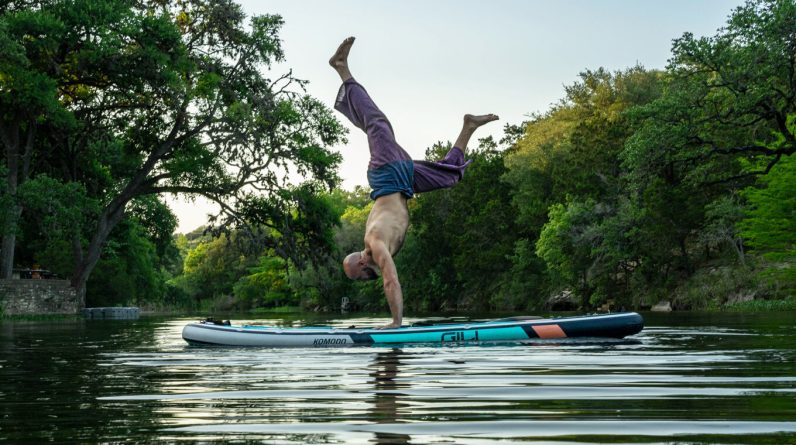
When it comes to paddleboarding or kayaking, finding the right anchor is crucial for a smooth and enjoyable experience on the water. But with so many options available, how do you choose the best anchor for your paddleboard or kayak? Whether you’re a seasoned water adventurer or a beginner looking to get started, this article will guide you through the different types of anchors and help you make an informed decision, ensuring your safety and peace of mind while out on the water. Get ready to discover the anchor that will keep you anchored in place, allowing you to fully embrace the beauty and tranquility of your surroundings.
Factors to Consider
When choosing an anchor for your paddleboard or kayak, there are several factors to consider. These factors will ensure that you select the best anchor for your specific needs and conditions. The main factors to consider include weight and size capacity, anchor type, anchor material, anchor design, and the environmental conditions in which you will be using the anchor.
Weight and Size Capacity
The weight and size capacity of the anchor are crucial factors to consider. You want to ensure that the anchor is strong enough to hold your paddleboard or kayak in place, even in strong currents or winds. It is important to check the weight and size capacity specifications provided by the manufacturer to ensure your safety on the water. Choosing an anchor with a weight and size capacity suitable for your watercraft is essential for a secure and stable paddleboarding or kayaking experience.
Anchor Type
There are various types of anchors available in the market, each with its unique features and benefits. The choice of anchor type primarily depends on the type of water you will be navigating and the conditions you will encounter. Some common anchor types for paddleboards and kayaks include grapple anchors, box anchors, fluke anchors, mushroom anchors, and sand anchors. Each type has its advantages and is suitable for different environments. Understanding the pros and cons of each anchor type will help you make an informed decision.
Anchor Material
The material of the anchor is vital for its durability and resistance to rust and corrosion. Several anchor materials are commonly used, including galvanized steel, stainless steel, aluminum, and plastic. Galvanized steel is highly durable and resistant to rust, making it an excellent choice for saltwater environments. Stainless steel offers similar benefits but is even more resistant to corrosion. Aluminum anchors are lightweight and ideal for smaller watercraft. Plastic anchors provide adequate strength with the added advantage of being lightweight and resistant to corrosion. Carefully consider the environmental conditions you will be encountering to choose the most suitable anchor material for your paddleboard or kayak.
Anchor Design
The design features of an anchor can greatly impact its performance and ease of use. Folding design anchors are popular because they are compact and easy to store. Multiple fluke anchors offer a higher holding power in soft bottoms. Weight distribution in an anchor helps to ensure its stability when deployed. Some anchors also come with a retrieval system, making it easier to retrieve the anchor without capsizing your paddleboard or kayak. Evaluate the different design features available and select an anchor design that aligns with your specific needs.
Environmental Conditions
The environmental conditions in which you will be using the anchor are crucial to ensure its effectiveness. Factors such as water depth, currents, tides, and bottom conditions all play a role in determining the type of anchor you should choose. In deeper waters, you may require a heavier anchor to ensure a secure hold. Strong currents and tides may require anchors with higher holding power. Additionally, different bottom conditions, such as sand, mud, or rocks, may require specific anchor types for optimal performance. Consider the environmental conditions that you will be navigating to select the most suitable anchor for your paddleboard or kayak.
Anchor Types
Now that you understand the factors to consider when choosing an anchor, let’s dive into the different anchor types available for paddleboards and kayaks. Each anchor type comes with its own set of advantages and is suitable for different water conditions and bottom surfaces.
Grapple Anchors
Grapple anchors, also known as claw anchors, are popular for their versatility and ease of use. These anchors feature multiple sharp prongs that dig into the bottom surface, providing a secure hold. Grapple anchors are suitable for sandy, muddy, and rocky bottoms. They offer excellent holding power and are relatively lightweight, making them an ideal choice for paddleboarders and kayakers.
Box Anchors
Box anchors are designed to provide high holding power with minimal effort. These anchors feature a unique folding design that allows them to collapse into a compact box shape for easy storage. When deployed, the box anchors unfold and dig into the bottom surface, providing a reliable hold. These anchors work well in a variety of bottom conditions, including sand, mud, and rocky bottoms. Box anchors are known for their ease of use and are a popular choice among paddleboarders and kayakers.
Fluke Anchors
Fluke anchors, also known as Danforth anchors, are widely recognized for their excellent holding power. These anchors feature sharp, pointed flukes that dig into the bottom surface, providing a strong hold. Fluke anchors are versatile and work well in sandy and muddy bottoms. They are lightweight and easy to manage, making them a popular choice for paddleboarding and kayaking enthusiasts.
Mushroom Anchors
Mushroom anchors are ideal for areas with soft bottoms, such as muddy or sandy seabeds. These anchors have a large surface area that allows them to sink into the soft bottom and create a suction effect, ensuring a secure hold. Mushroom anchors are generally lightweight and compact, making them easy to store and deploy. They are a suitable choice for paddleboarders and kayakers who frequently navigate areas with soft bottom conditions.
Sand Anchors
Sand anchors are specifically designed for sandy bottoms. These anchors feature a unique shape that allows them to sink deep into the sand, providing a reliable hold. Sand anchors are lightweight and easy to handle, making them a popular choice for paddleboards and kayaks. They are suitable for calm conditions and can be easily set up and retrieved.
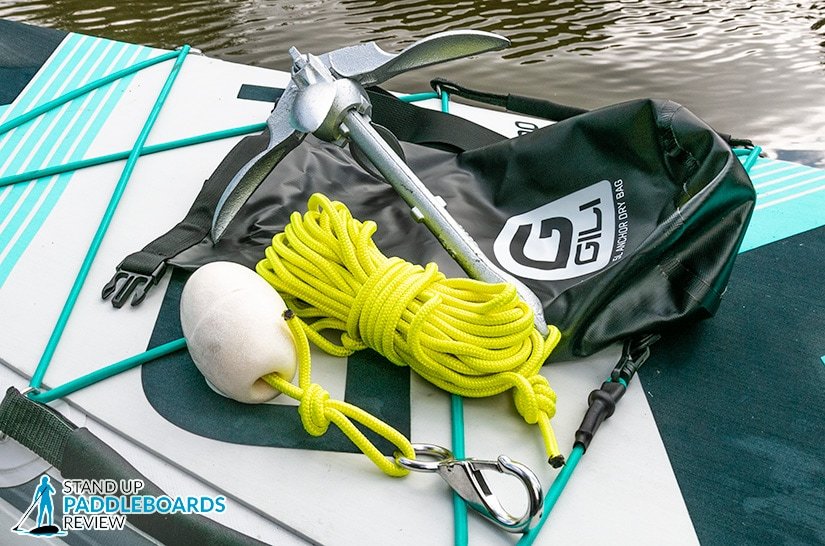
This image is property of standuppaddleboardsreview.b-cdn.net.
Anchor Materials
The material of the anchor directly impacts its durability, strength, and resistance to rust and corrosion. Various anchor materials are available, and understanding their benefits and limitations will help you make an informed decision.
Galvanized Steel
Galvanized steel anchors are highly durable and resistant to rust and corrosion. They are a popular choice for saltwater environments due to their ability to withstand the harsh conditions. Galvanized steel anchors offer excellent strength but can be heavier compared to other materials. However, the added weight provides increased stability and holding power, making them an ideal choice for paddleboarders and kayakers navigating rough waters.
Stainless Steel
Stainless steel anchors offer similar benefits to galvanized steel anchors but with even greater resistance to corrosion. These anchors are perfect for saltwater environments as they can withstand prolonged exposure to the elements without rusting or corroding. Stainless steel anchors provide excellent strength and durability while being relatively lightweight. They are a reliable choice for paddleboarders and kayakers who prioritize longevity and resistance to rust.
Aluminum
Aluminum anchors are lightweight and easy to handle, making them an excellent choice for smaller watercraft such as paddleboards and kayaks. These anchors offer sufficient strength while being significantly lighter compared to steel anchors. Aluminum anchors are resistant to rust and corrosion, making them suitable for both freshwater and saltwater environments. They are an ideal choice for paddleboarders and kayakers looking for a lightweight yet reliable anchor option.
Plastic
Plastic anchors are lightweight and resistant to rust and corrosion. They offer adequate strength for smaller watercraft and are often budget-friendly. While plastic anchors may not have the same durability as steel or aluminum anchors, they are suitable for calmer environments with minimal wind and current. Plastic anchors are an affordable option for casual paddleboarders and kayakers who do not frequently encounter challenging water conditions.
Anchor Design Features
The design features of an anchor play a significant role in its performance, ease of use, and storage options. When selecting an anchor, consider these design features to ensure the anchor meets your specific needs.
Folding Design
Anchors with a folding design are highly convenient for paddleboarders and kayakers. These anchors can be easily collapsed into a compact shape, allowing for easy storage and transport. Folding anchors are particularly useful for those with limited storage space or who frequently travel with their watercraft. This design feature provides a practical solution for secure anchoring while prioritizing convenience and portability.
Multiple Flukes
Anchors with multiple flukes provide increased holding power, especially in soft bottoms such as sand or mud. The flukes dig into the bottom surface, ensuring a secure hold even in challenging conditions. Multiple fluke anchors are popular among paddleboarders and kayakers who navigate areas with soft bottoms or encounter stronger currents. The additional holding power offered by multiple flukes provides peace of mind and enhances safety on the water.
Weight Distribution
Anchors with a well-designed weight distribution feature offer increased stability and holding power. These anchors are strategically designed to distribute the weight evenly, preventing the anchor from flipping or dragging. Weight distribution is particularly crucial when faced with strong winds or currents. The proper weight distribution ensures that your paddleboard or kayak remains securely anchored even in challenging conditions.
Retrieval System
Anchors with a retrieval system make the process of retrieving the anchor much easier and safer. These systems typically use a buoy and line combination that allows you to pull the anchor to the surface without capsizing your watercraft. The retrieval system eliminates the need to manually pull up the anchor, which can be physically demanding and potentially dangerous. When choosing an anchor, consider adding a retrieval system to enhance your overall anchoring experience.
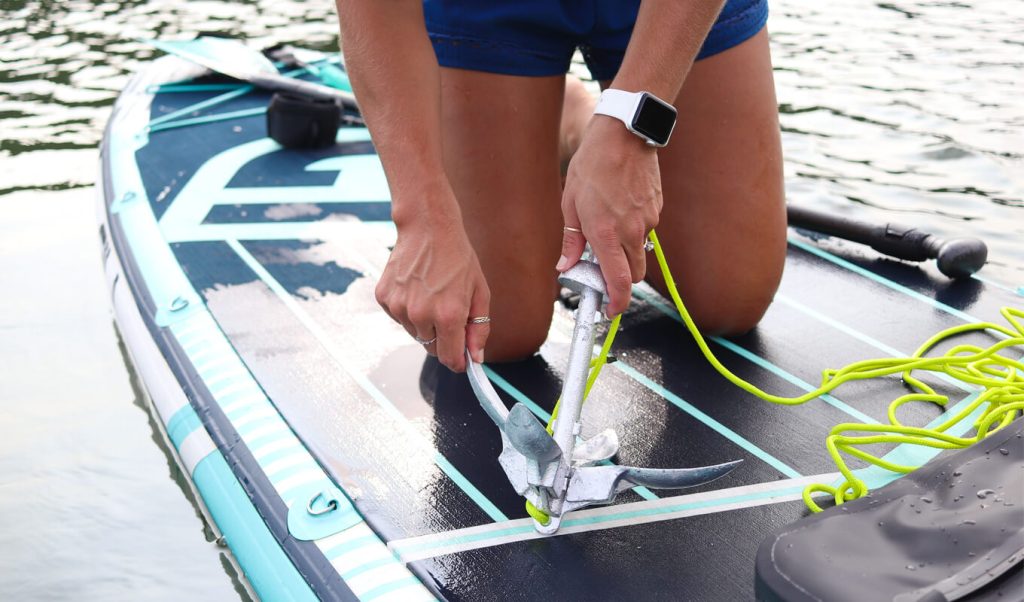
This image is property of cdn.shopify.com.
Environmental Conditions
Understanding the environmental conditions in which you will be using the anchor is crucial to ensure its effectiveness and your safety on the water. Consider these factors when selecting an anchor for your paddleboard or kayak.
Water Depth
The water depth is a crucial consideration as it determines the length of anchor cable you will need. Deeper waters require longer anchor cables to ensure a secure hold. Consider the typical depths you will be navigating and choose an anchor cable length that accommodates those depths. It is better to have a slightly longer anchor cable than one that is too short and compromises the stability and security of your watercraft.
Currents and Tides
Strong currents and tides can pose a challenge when anchoring your paddleboard or kayak. You will need an anchor that can withstand these forces and maintain a secure hold. Anchors with higher holding power or multiple flukes tend to perform better in challenging currents and tides. Evaluate the typical currents and tides in your area and choose an anchor that can withstand those specific conditions for a safe and worry-free experience.
Bottom Conditions
Different bottom conditions, such as sand, mud, or rocks, require different anchor types for optimal performance. Sandy bottoms often require anchors that can easily penetrate the sand, such as sand anchors or fluke anchors. Muddy bottoms may call for anchors with a large surface area, such as mushroom anchors or box anchors, to create a suction effect. In rocky bottoms, anchors with sharp prongs, like grapple anchors, are preferred for a secure hold. Consider the bottom conditions you are likely to encounter and choose an anchor accordingly to ensure optimal anchoring performance.
Anchor Cable
In addition to the anchor itself, the anchor cable also plays a crucial role in anchoring your paddleboard or kayak. Consider these factors when selecting an anchor cable.
Length
The length of the anchor cable is determined by the water depth in which you will be navigating. It is important to have enough anchor cable to ensure a secure hold. The anchor cable should be long enough to reach the bottom surface while leaving adequate slack to account for wave action, tides, and currents. Consider the water depths you will be navigating and choose an anchor cable length that accommodates those depths for a stable and secure anchoring experience.
Thickness
The thickness of the anchor cable impacts its strength and durability. Thicker cables generally offer greater strength and are less likely to break or fray. However, thicker cables can be heavier and bulkier, which may impact the ease of handling and storage. Strike a balance between cable thickness and your specific needs to ensure optimal performance and convenience.
Chain vs. Rope
When choosing an anchor cable, you have the option of using a chain or rope. Chains are known for their durability and resistance to abrasion, making them suitable for rough conditions or areas with rocky bottoms. However, chains can be heavier and more challenging to handle compared to ropes. Ropes, on the other hand, are lightweight and easy to manage, making them ideal for casual paddleboarders or kayakers. Evaluate the conditions in which you will be using the anchor and choose between a chain or rope based on your specific needs and preferences.
Buoy
Attaching a buoy to the anchor cable provides several benefits. The buoy marks the location of your anchor, making it easier to locate and retrieve. Additionally, the buoy keeps the anchor cable visible on the surface, reducing the risk of entanglement with other watercraft or obstacles. Consider adding a buoy to your anchor cable for enhanced safety and ease of use on the water.

This image is property of cdn.shopify.com.
Anchor Storage
Proper storage of your anchor is essential to prolong its lifespan and ensure that it remains in optimal condition. Consider these storage options for your paddleboard or kayak anchor.
Onboard Storage Solutions
Many paddleboards and kayaks come with built-in storage compartments or bungee cord systems that allow you to secure your anchor while on the water. Utilizing these onboard storage solutions keeps your anchor readily accessible and prevents it from shifting during transport or while navigating rough waters. Take advantage of the onboard storage options provided by your watercraft to ensure a secure and organized anchor storage solution.
External Storage Options
If your paddleboard or kayak does not have built-in storage options, there are various external storage options available. Anchor bags or mesh storage bags are popular choices for external anchor storage. These bags can be securely attached to your watercraft using straps or bungee cords, ensuring that the anchor remains in place during transport or water activities. External storage options provide flexibility and convenience for storing your anchor when not in use.
Anchor Accessories
Several anchor accessories can enhance your overall anchoring experience and make it more convenient and efficient. Consider these accessories for a well-equipped paddleboarding or kayaking setup.
Anchor Trolley Systems
Anchor trolley systems are versatile and practical accessories that allow you to easily adjust the position of your anchor. These systems consist of pulleys and lines that enable you to move the anchor from bow to stern or anywhere in between. Anchor trolley systems offer flexibility in anchoring positions and make it easier to adapt to changing wind or current conditions. Invest in an anchor trolley system to optimize your anchoring capabilities and enhance your paddling experience.
Anchor Cleats
Anchor cleats are simple yet effective devices that provide a secure attachment point for your anchor line. These cleats are typically mounted on the deck of your paddleboard or kayak, allowing you to quickly and securely tie off your anchor line. Anchor cleats prevent your anchor line from slipping or coming loose, ensuring a secure hold. Add anchor cleats to your watercraft for easy anchor line management and enhanced safety during your paddleboarding or kayaking adventures.
Anchor Lines
Choosing the right anchor line is crucial for secure anchoring. Nylon lines are popular due to their strength, elasticity, and resistance to UV rays. Nylon lines offer excellent shock absorption, which is particularly important when anchoring in areas with wave action or strong currents. Consider the length and thickness of the anchor line, ensuring it is suitable for the water depths and conditions you will encounter. Invest in a high-quality anchor line to ensure a reliable hold and peace of mind on the water.
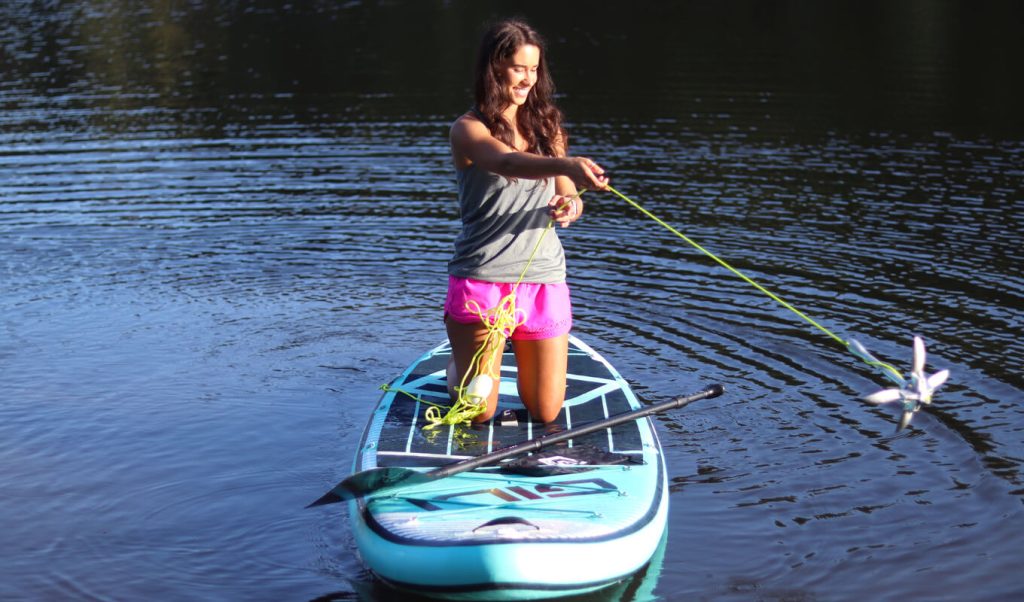
This image is property of cdn.shopify.com.
Personal Preference and Experience
Personal preference and experience should not be overlooked when choosing an anchor for your paddleboard or kayak. Every paddler’s needs and preferences may vary. What works well for one person may not necessarily work for another. It is important to experiment and find what anchor type, material, and design features align with your specific requirements. Additionally, seek out feedback and recommendations from fellow paddleboarders or kayakers who have experience with different anchors. Their insights can provide valuable guidance in selecting the best anchor for your watercraft.
Trial and Error
Finding the perfect anchor may involve some trial and error. It is common for paddlers to try out different anchor types or designs before settling on the one that is most effective for their specific needs. Don’t be discouraged if you don’t find the ideal anchor right away. Embrace the process of trial and error, and use each experience as an opportunity to learn and refine your anchoring setup.
Feedback and Recommendations
Reach out to other paddleboarders or kayakers for their feedback and recommendations on anchor options. Engage with online communities, join paddling groups, or participate in local events to connect with experienced water enthusiasts. They can provide valuable insights based on their own experiences and help guide you in selecting the best anchor for your paddleboard or kayak. Take advantage of their knowledge and expertise to make an informed decision.
Budget Considerations
Budget considerations are important when purchasing an anchor and additional accessories for your paddleboard or kayak. While it is essential to invest in a high-quality anchor that meets your specific needs, it is also important to consider your budget constraints. Evaluate the cost of different anchors and accessories, and strike a balance between quality and affordability.
Cost of Anchors
Anchors vary in price depending on their type, material, and design features. Steel anchors, such as galvanized steel or stainless steel, are generally more expensive compared to aluminum or plastic anchors. Consider your needs, the environmental conditions you will encounter, and your budget when assessing the cost of anchors. It is advisable to invest in a durable and reliable anchor that provides the necessary holding power while aligning with your budget.
Additional Accessories
In addition to the anchor itself, there may be additional accessories you need to consider. These accessories, such as anchor trolley systems, cleats, or anchor lines, can supplement your anchoring setup and enhance your overall experience on the water. Assess the cost of these accessories and prioritize based on your specific needs and preferences. Determine which accessories are essential for your paddleboarding or kayaking adventures and allocate your budget accordingly.
In conclusion, selecting the best anchor for your paddleboard or kayak involves considering various factors, including weight and size capacity, anchor type, anchor material, anchor design, and environmental conditions. Grapple anchors, box anchors, fluke anchors, mushroom anchors, and sand anchors are common anchor types for watercraft. Anchor material options include galvanized steel, stainless steel, aluminum, and plastic, each with its own advantages and suitability for different conditions. Different anchor design features, such as folding design, multiple flukes, weight distribution, and retrieval systems, contribute to an anchor’s performance and ease of use. Understanding the environmental conditions, such as water depth, currents and tides, and bottom conditions, is crucial for selecting an anchor that offers optimal holding power. Anchor cable length, thickness, choice between chain and rope, and the use of a buoy should be considered for a secure anchoring experience. Proper storage, anchor accessories like trolley systems, cleats, and anchor lines, personal preference, and budget considerations are also important factors to take into account. By considering all these factors, you can confidently choose the best anchor for your paddleboard or kayak, ensuring a safe and enjoyable experience on the water.
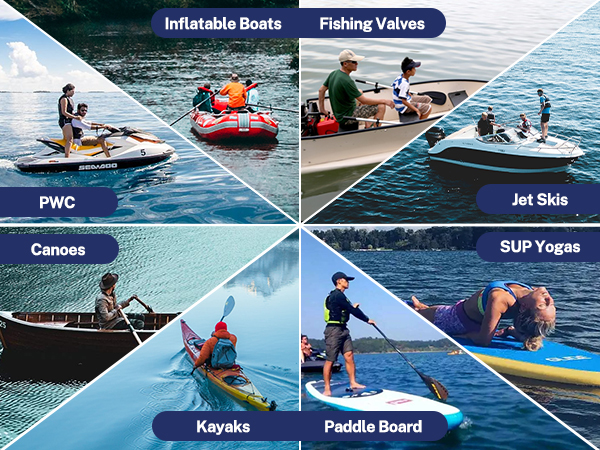
This image is property of Amazon.com.






